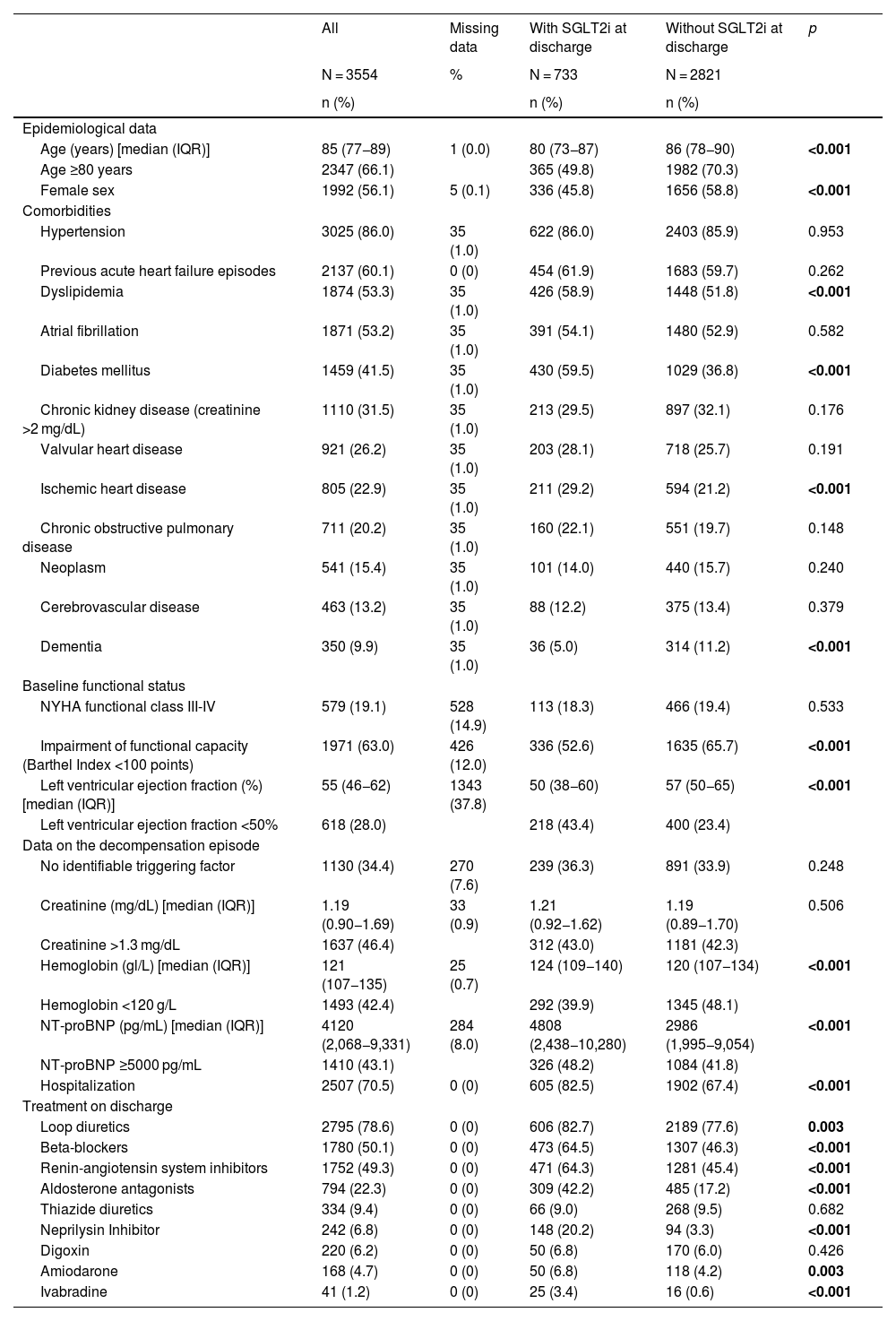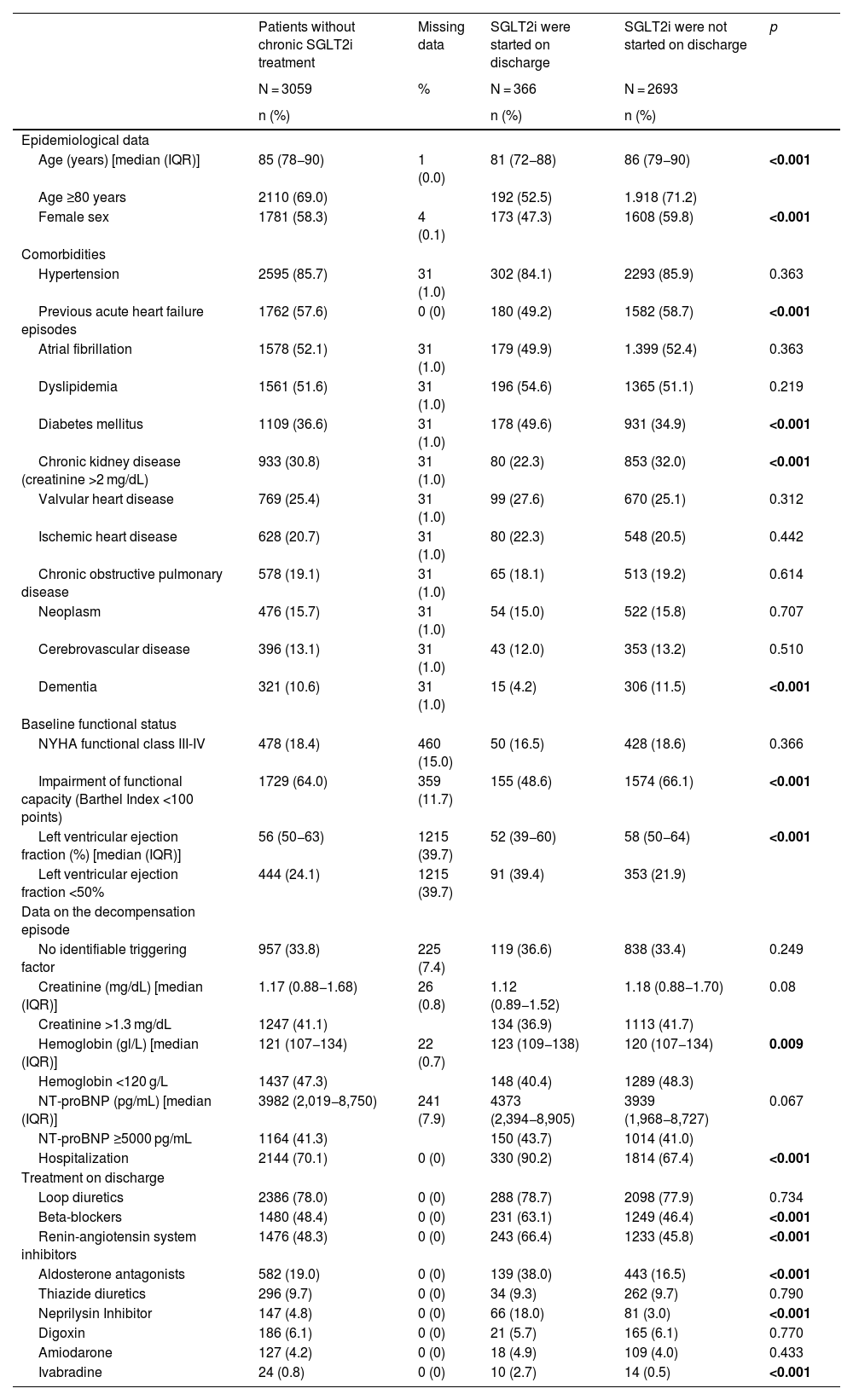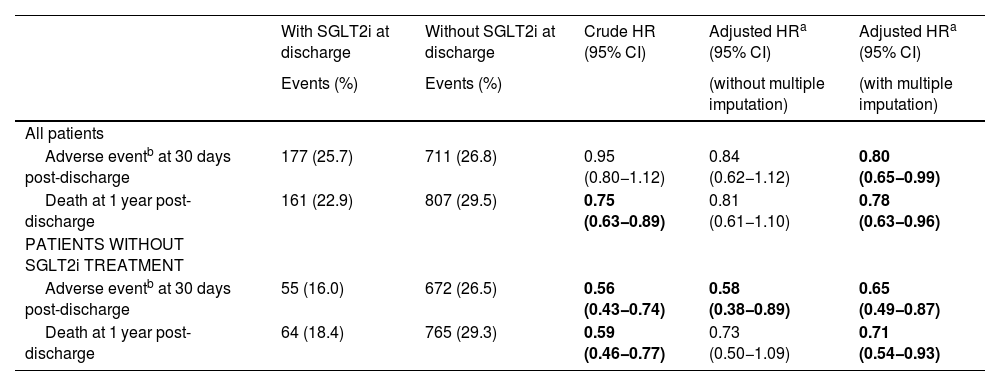To analyze the factors associated with the use of sodium-glucose cotransporter 2 inhibitors (SGLT2i) and the association between use SGLT2i and post discharge adverse clinical endpoints (composite of 30-day visit to emergency department or acute heart failure -AHF- readmission or death) and 1-year mortality.
MethodsWe included all patients diagnosed with AHF in 40 Spanish emergency departments (ED) in November-December 2022 with available data on chronic treatment and at discharge and grouped them according to whether they received iSGLT2 at discharge. Treatment with SGLT2i was categorized in never user, prior use and initiation during decompensation. In multivariable models adjusted for 31 independent variables, we investigated factors associated with iSGLT2 use at discharge and with new initiation of iSGLT2 treatment at discharge, and the relationship between iSGLT2 treatment and 30-day adverse events and 1-year mortality.
Results3554 patients were included (median age: 85 years, 56% women, 71% hospitalized): 495 (13.9%) were already receiving iSGLT2 before decompensation and 733 (20.6%) were discharged with iSGLT2. The use of iSGLT2 at discharge was directly associated with prior iSGLT2 treatment, diabetes mellitus, hospitalization, and discharge prescription of other drugs recommended for heart failure, and inversely with previous episodes of AHF and dementia. Initiation of iSGLT2 during decompensation was inversely associated with these factors and also inversely associated with chronic renal failure. Treatment with iSGLT2 at discharge was associated with a lower risk of adverse events at 30 days (adjusted HR 0.80, 95%CI 0.65−0.99) and death at 1 year (0.78, 0.63−0.96). These beneficial effects were also observed when iSGLT2 was initiated during decompensation (0.65, 0.49−0.87; and 0.71, 0.54−0.93; respectively), and the reduction in adverse events at 30 days was even better in new-onset cases (interaction p: 0.02).
ConclusionThe use of iSGLT2 after an AHF episode is low, is higher in patients who were hospitalized, and is associated with fewer 30-day adverse events and deaths at 1 year compared with patients not receiving iSGLT2. Patients who initiate iSGLT2 during decompensation have an even greater decrease in 30-day adverse events than patients on chronic therapy.
Analizar los factores asociados al uso de inhibidor del cotransportador de sodio-glucosa 2 (iSGLT2), al inicio de este tratamiento tras el alta por un episodio de insuficiencia cardiaca aguda (ICA) y su relación con resultados adversos clínicos a corto y largo plazo.
MétodoSe incluyeron todos los pacientes diagnosticados de ICA en 40 servicios de urgencias (SU) españoles en noviembre-diciembre de 2022 con datos disponibles del tratamiento crónico y al alta, y se agruparon según si recibieron iSGLT2 al alta. Los pacientes se categorizaron en: a) no uso de iSGLT2, b) uso previo y c) inicio durante descompensación. En modelos multivariable ajustados por 31 variables independientes, se investigaron los factores asociados al uso de iSGLT2 al alta, su inicio durante la descompensación y su asociación con episodios adversos a 30 días (reconsulta a urgencias, hospitalización por IC o muerte) y mortalidad al año.
ResultadosSe incluyeron 3.554 pacientes (mediana de edad: 85 años, 56% mujeres, 71% hospitalizados): 495 (13,9%) ya recibían iSGLT2 antes de la descompensación y 733 (20,6%) fueron dados de alta con iSGLT2. El uso de iSGTL2 al alta se asoció directamente con tratamiento previo con iSGLT2, diabetes mellitus, hospitalización y prescripción al alta de otros fármacos recomendados para la insuficiencia cardiaca, e inversamente con episodios previos de ICA y demencia. El inicio de iSGLT2 durante la descompensación se asoció a estos factores y además inversamente con insuficiencia renal crónica. El tratamiento con iSGLT2 al alta se asoció con un menor riesgo de eventos adversos a 30 días (HR ajustada 0,80, IC95% 0,65-0,99) y de muerte a 1 año (0,78, 0,63-0,96). Estos efectos beneficiosos también se observaron cuando los iSGLT2 se iniciaron durante la descompensación (0,65, 0,49-0,87; y 0,71, 0,54-0,93; respectivamente), y la reducción de eventos adversos a 30 días fue incluso mejor en los casos de nuevo inicio (p interacción: 0,02).
ConclusiónEl uso de iSGLT2 tras un episodio de ICA es bajo, su prescripción aumenta en pacientes que fueron hospitalizados y se asocia a menos eventos adversos a 30 días y muertes al año en comparación con los pacientes que no reciben iSGLT2. Los pacientes que inician los iSGLT2 durante la descompensación tienen una disminución de eventos adversos a 30 días incluso mayor a la que tienen los pacientes en tratamiento crónico.
Article
Diríjase desde aquí a la web de la >>>FESEMI<<< e inicie sesión mediante el formulario que se encuentra en la barra superior, pulsando sobre el candado.

Una vez autentificado, en la misma web de FESEMI, en el menú superior, elija la opción deseada.

>>>FESEMI<<<











